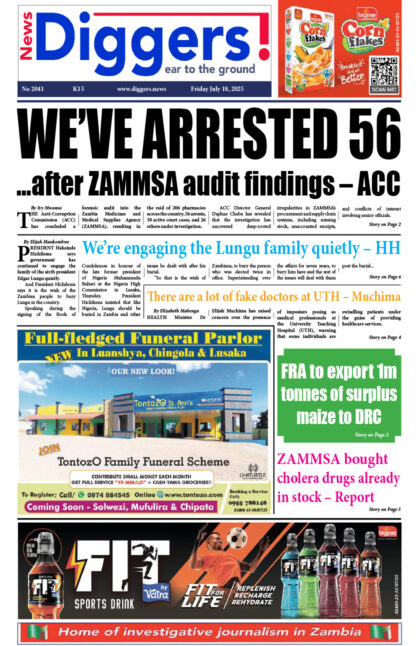The World Bank has predicted that Zambia will suffer a worse than expected trade deficit and foreign exchange position due to the on-going tariff war between China and the USA which could lower copper prices.
And the World Bank has advised the Zambian government to come up with a debt strategy that is in line with the country’s medium term expenditure framework.
Meanwhile, the World bank has projected a decline of GDP growth to 2.5 percent from 3.3 percent projected in March this year following heightened macro-fiscal challenges.
In the July 2019 Zambia economic brief dubbed “Wealth beyond mining: leveraging renewable natural capital”, the World Bank said intensification of the on-going tariff war between China and the USA would affect Zambia’s foreign exchange position.
“External risks include the intensification of the on-going tariff war between China and the USA which would lower copper prices leading to a worse than expected trade deficit and foreign exchange position, the possibility that oil prices will increase due to production losses arising from political disputes involving the USA with Iran and Venezuela, leading to weakened terms of trade for Zambia and a quicker than expected normalization of interest rates in the USA that would tighten global financing conditions leading to higher costs of external financing and the USA and other advanced economies tighten monetary policy faster than anticipated leading to tightened global financing conditions and higher costs of external financing,” the report read.
And the World Bank called for the strengthening of debt management to reduce the debt service burden and minimise debt related vulnerabilities.
“In addition to curtailing the accumulation of new debt, (especially foreign currency-dominated), this would reduce the debt service burden and unlock the fiscal space for policies that promote inclusive and sustainable growth. Thus, government’s commitment to developing and adhering to a debt management strategy that is in line with a medium-term expenditure framework is critical. The government committed to publishing comprehensive debt reports to enhance transparency and has taken steps to build capacity for this function. It is now critical to publish these reports starting in 2019. Ideally, this should include systematic and timely annual debt reports, quarterly debt statistical bulletins, ad-hoc information on debt and risks and analytical reports. A website dedicated to debt management and an investor relations unit in the debt management office would be a critical part of this. The World Bank is supporting the government to strengthen various areas of debt management identified in the 2018 Debt Management Performance Assessment (DeMPA),” read the report.
“Over the near and medium term, Zambia needs to address its unsustainable debt situation. This will unlock private sector growth and create space for the pursuance of macro-fiscal policies which promote inclusive and sustainable growth. They need to Front-load fiscal consolidation and structural reforms to bring back the risk of debt sustainability to medium level and create fiscal space for inclusive growth. Fiscal outturns in recent years have tended to be weaker than budgeted, partly reflecting the weak implementation of fiscal reform plans. Moreover, the new medium term expenditure framework (MTEF) proposes to add 9.6 percent of GDP in new external debt disbursements. Such a fiscal path would be inconsistent with delivering primary fiscal balances that help reduce the debt burden over the medium term, front-loaded fiscal adjustment efforts that include both revenue mobilization and expenditure streamlining measures will help ensure domestic and external stability, unlock private sector activity and uplift growth prospects.”
The institution noted that an IMF program would lead to the direct disbursement of foreign exchange given the current macroeconomic imbalances and weak market confidence.
“Foreign exchange reserves have continued to deteriorate reaching US$1.4 billion as at end, April 2019 (representing 1.7 months of import cover), reflecting heightening external imbalances. At least four months of import cover is needed to cushion Zambia’s vulnerability to terms-of-trade or global monetary and financial shocks. Meanwhile, external debt service is programmed to consume US$ 1.5 billion in forex outflows in 2019. Slowing external debt accumulation and reinforcing the ongoing debt management reforms are key to the broader plan of rebuilding reserves. Given the current macroeconomic imbalances and weak market confidence, an IMF program would lead to the direct disbursement of foreign exchange, crowd-in budget support from other development partners and raise market confidence. In the absence of a fund program, full and clear implementation of the reforms announced by the former minister of finance would send an important signal of governments’ commitment to strengthen macroeconomic stability and growth,” the report read.
Meanwhile, the World Bank projected a decline of GDP growth to 2.5 percent from 3.3 percent projected in March this year following heightened macro-fiscal challenges.
“In the medium term, GDP growth is projected at 2.5 percent which is a decline from 3.3 percent in march 2019, reflecting heightened macro-fiscal challenges and a weaker than expected crop harvest. Over the medium term, agriculture is expected to pick up as new irrigation projects come on stream and the farmer input supply program improves with the implementation of the e-voucher distribution system. However, in the absence of strong macroeconomic adjustment, growth is projected to remain under 3.0 percent,” read the report.
“On the domestic front, the main risks relate to delays in implementing the necessary fiscal consolidation efforts which would lead to further tightening of domestic and external financing conditions, further build up of domestic payment arrears and rising debt servicing constraints; a delayed implementation of ZESCO reforms which would worsen its financial situation and undermine reliable energy supply with corresponding negative implications on the economy, especially on industrial activity. A failure to find an amicable resolution to the on-going dispute over new mining taxes that would affect investment and production in the sector and a protracted El Nino that would restrain recovery of agricultural production.”



















